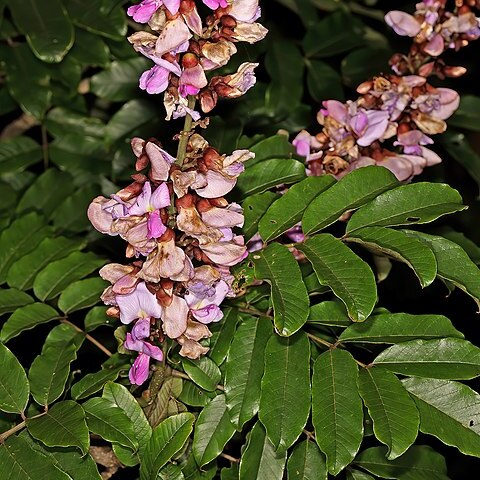Tree or shrub, sometimes stunted or gnarled, 2-13 m tall; bark grey or brown, smooth to ± flaky. Leaves 7-13(15)-foliolate; petiole 2-4.5(6) cm long; rachis 4.5-10.5 cm long; leaflets 2-9 x 1.5-4 cm, elliptic or oblong to oblong-elliptic or ovate-elliptic, rounded to acute and apiculate at the apex, rounded to cuneate at the base, glabrous on upper surface, finely appressed-pubescent beneath; lateral nerves in 9-12(16) pairs; stipules 4-6 mm long, deciduous; stipels 2-4 mm long, persistent; petiolules 3-4 mm long; characteristic curved striate buds in the leaf-axils. Inflorescences branched panicles, 14-26 cm long; branches 1.5-8 cm long; bracts 1.7 mm long; pedicels 2.5-4 mm long; bracteoles 1.5-2 mm long, ovate, deciduous. Calyx with silvery grey to dark brown velvety hairs; tube 2-4 mm long; lobes 2-2.5 mm long, rounded ovate, the upper two united except for the apical 0.3 mm. Corolla violet, standard 1.3-1.6 x 1.2-1.3 cm, ± round, with transverse callus, silvery grey shiny silky pilose outside, with claw 2.5-3 mm long; wing-blades 13-14 x 4.5 mm, oblong-elliptic, with spur 1 mm long and claw 3 mm long; blades of keel petals 9-12 x 6 mm, elliptic, toothed at the base on upper side and with claw 3 mm long. Stamen sheath 1-1.3 cm long; free parts of filaments 4-5 mm long; anthers 0.8-1 mm long; upper filament free at the base. Ovary 8 mm long, densely silky with light brown hairs, 5-ovuled; style 4.5 mm long, glabrous, bent through 40-45°; stigma small. Pods woody, 5.5-9(15) x 1.5-2.7(3.5) cm, oblong or oblanceolate, margined, densely dark brown velvety when young, later glabrescent, with short beak, 1-3-seeded. Seeds brownish-black, 12(20) x 9 mm, oblong, compressed.
Medium-sized, evergreen to semi-deciduous tree, up to 13 m high, sometimes up to 25 m high in forests, with a somewhat flattened crown. Bark pale brown to grey, smooth to flaky; young parts reddish brown hairy. Leaves compound with 3-7 pairs of opposite leaflets and a terminal one. Leaflets entire, oblong to narrowly elliptic; lower surface with conspicuous, parallel, well-spaced lateral veins, fine silky hairy; stipellae usually present, linear. Flowers in erect, dense, terminal racemes much longer than leaves. Calyx campanulate, somewhat 2-lipped. Petals mauve to purple; standard conspicuous with oblong claw; wing falcate-ovate, claw broad; keel incurved, obtuse, clawed. Flowering time Dec.-Feb. Pod erect, woody, flat, dehiscent, golden-brown, velvety. Wood hard and strong, making beautiful durable furniture; seeds and roots used medicinally.
Leaves 7–13(15)-foliolate; petiole 2–4.5(6) cm long; rachis 4.5–10.5 cm long; leaflets 2–9 × 1.5–4 cm, elliptic or oblong to oblong-elliptic or ovate-elliptic, rounded to acute and apiculate at the apex, rounded to cuneate at the base, glabrous on upper surface, finely appressed-pubescent beneath; lateral nerves in 9–12(16) pairs; stipules 4–6 mm long, deciduous; stipels 2–4 mm long, persistent; petiolules 3–4 mm long; characteristic curved striate buds in the leaf-axils.
A shrub or tree. It grows up to 13 m tall. The leaves have 7-13 leaflets. The leaflets are 2-9 cm long by 1.5-4 cm wide. The flowers are in branched groups 14-26 cm long. They are violet. The fruit is a woody pod 5.5-9 cm long by 1.5-2.7 cm wide. They have a brown velvety coating when young. There are 1-3 seeds. These are brownish-black and 12 mm long by 9 mm wide.
Corolla violet, standard 1.3–1.6 × 1.2–1.3 cm, ± round, with transverse callus, silvery grey shiny silky pilose outside, with claw 2.5–3 mm long; wing-blades 13–14 × 4.5 mm, oblong-elliptic, with spur 1 mm long and claw 3 mm long; blades of keel petals 9–12 × 6 mm, elliptic, toothed at the base on upper side and with claw 3 mm long.
Pods woody, 5.5–9(15) × 1.5–2.7(3.5) cm, oblong or oblanceolate, margined, densely dark brown velvety when young, later glabrescent, with short beak, 1–3-seeded.
Inflorescences branched panicles, 14–26 cm long; branches 1.5–8 cm long; bracts 1.7 mm long; pedicels 2.5–4 mm long; bracteoles 1.5–2 mm long, ovate, deciduous.
Calyx with silvery grey to dark brown velvety hairs; tube 2–4 mm long; lobes 2–2.5 mm long, rounded ovate, the upper two united except for the apical 0.3 mm.
Ovary 8 mm long, densely silky with light brown hairs, 5-ovuled; style 4.5 mm long, glabrous, bent through 40–45°; stigma small.
Stamen sheath 1–1.3 cm long; free parts of filaments 4–5 mm long; anthers 0.8–1 mm long; upper filament free at the base.
Tree or shrub, sometimes stunted or gnarled, 2–13 m tall ; bark grey or brown, smooth to ± flaky.
Seeds brownish-black, 12(20) × 9 mm, oblong, compressed.


